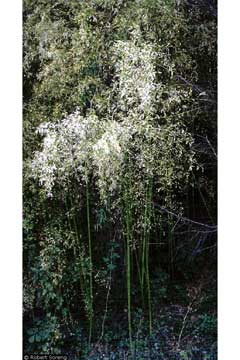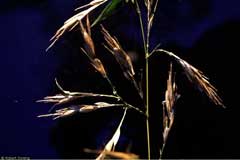 |
|
Robert Soreng @ USDA-NRCS PLANTS Database |
 |
| Robert Soreng @ USDA-NRCS PLANTS Database |
Translate this page:
Summary
Physical Characteristics

 Phyllostachys flexuosa is an evergreen Bamboo growing to 6 m (19ft) by 6 m (19ft).
Phyllostachys flexuosa is an evergreen Bamboo growing to 6 m (19ft) by 6 m (19ft).
See above for USDA hardiness. It is hardy to UK zone 6. It is in leaf all year. The species is hermaphrodite (has both male and female organs) and is pollinated by Wind.
Suitable for: light (sandy), medium (loamy) and heavy (clay) soils. Suitable pH: mildly acid, neutral and basic (mildly alkaline) soils. It can grow in semi-shade (light woodland). It prefers moist soil.
UK Hardiness Map
US Hardiness Map
Synonyms
Bambusa flexuosa.
Plant Habitats
Woodland Garden Sunny Edge; Dappled Shade; Shady Edge;
Edible Uses
Edible Parts: Shoots Stem
Edible Uses:
Young shoots - cooked[25, 61, 105, 177]. A delicious flavour[266]. Slightly acrid raw, they are usually boiled in at least one change of water and added to salads etc[183]. The canes are about 10mm in diameter[K]. The shoots, which are generally 2- 4cm in diameter, though occasionally up to 7cm[266], are harvested in the spring when they are about 8cm above the ground, cutting them about 5cm below soil level.
References More on Edible Uses
Medicinal Uses
Plants For A Future can not take any responsibility for any adverse effects from the use of plants. Always seek advice from a professional before using a plant medicinally.
None known
References More on Medicinal Uses
The Bookshop: Edible Plant Books
Our Latest books on Perennial Plants For Food Forests and Permaculture Gardens in paperback or digital formats.

Edible Tropical Plants
Food Forest Plants for Hotter Conditions: 250+ Plants For Tropical Food Forests & Permaculture Gardens.
More

Edible Temperate Plants
Plants for Your Food Forest: 500 Plants for Temperate Food Forests & Permaculture Gardens.
More

More Books
PFAF have eight books available in paperback and digital formats. Browse the shop for more information.
Shop Now
Other Uses
Basketry Wood
The canes are not of the highest quality but can be used for plant supports etc. The medium quality wood is good for all standard bamboo uses for canes of this size[195]. The culms are used as handles of tools[266]. The splints made from the stems are used for weaving articles[266].
Special Uses
Food Forest
References More on Other Uses
Cultivation details
Requires a rich damp soil in a sheltered position[200] and plenty of moisture in the growing season[1]. A very hardy plant, tolerating temperatures down to about -17°c. According to another report the plant only suffers minor leaf damage at -22°c[195]. The plants dislike prolonged exposure to hard frosts[200]. This species is notably resistant to honey fungus[200]. Plants only flower at intervals of many years. When they do come into flower most of the plants energies are directed into producing seed and consequently the plant is severely weakened. They sometimes die after flowering, but if left alone they will usually recover though they will look very poorly for a few years. If fed with artificial NPK fertilizers at this time the plants are more likely to die[122]. A plant at Trebah gardens in Cornwall was flowering heavily in May 1995[K]. This is a good companion species to grow in a woodland because the plants are shallow rooted and do not compete with deep rooted trees[195]. The rootstock is running[25] but not aggressively so, especially in the cooler climate of Britain[200]. New growth appears from late March[25]. This species is closely related to P. angusta[266]. Plants need quite a lot of space because the outer culms spread out sideways and arch over[162].
References Carbon Farming Information and Carbon Sequestration Information
Temperature Converter
Type a value in the Celsius field to convert the value to Fahrenheit:
Fahrenheit:
The PFAF Bookshop
Plants For A Future have a number of books available in paperback and digital form. Book titles include Edible Plants, Edible Perennials, Edible Trees,Edible Shrubs, Woodland Gardening, and Temperate Food Forest Plants. Our new book is Food Forest Plants For Hotter Conditions (Tropical and Sub-Tropical).
Shop Now
Plant Propagation
Seed - surface sow as soon as it is ripe in a greenhouse at about 20°c. Do not allow the compost to dry out. Germination usually takes place fairly quickly so long as the seed is of good quality, though it can take 3 - 6 months. Grow on in a lightly shaded place in the greenhouse until large enough to plant out. Seed is rarely available. Division in spring as new growth commences. Divisions from the open ground do not transplant well, so will need careful treatment and nurturing under cover in pots until at least late spring[238]. Division is best carried out in wet weather and small divisions will establish better than large clumps[238]. Another report says that you can take large divisions from established clumps and transfer them straight to their permanent positions, misting or drenching them frequently until they are established[200]. Basal cane cuttings in spring.
Other Names
If available other names are mentioned here
Native Range
TEMPERATE ASIA: China (Anhui Sheng, Hebei Sheng, Henan Sheng, Shaanxi Sheng (c.), Shanxi Sheng, Yunnan Sheng)
Weed Potential
Right plant wrong place. We are currently updating this section.
Please note that a plant may be invasive in one area but may not in your area so it's worth checking.
Conservation Status
IUCN Red List of Threatened Plants Status :

Growth: S = slow M = medium F = fast. Soil: L = light (sandy) M = medium H = heavy (clay). pH: A = acid N = neutral B = basic (alkaline). Shade: F = full shade S = semi-shade N = no shade. Moisture: D = dry M = Moist We = wet Wa = water.
Now available:
Food Forest Plants for Mediterranean Conditions
350+ Perennial Plants For Mediterranean and Drier Food Forests and Permaculture Gardens.
[Paperback and eBook]
This is the third in Plants For A Future's series of plant guides for food forests tailored to
specific climate zones. Following volumes on temperate and tropical ecosystems, this book focuses
on species suited to Mediterranean conditions—regions with hot, dry summers and cool, wet winters,
often facing the added challenge of climate change.
Read More
Expert comment
Author
(Carrière.)Rivière.&C.Rivière.
Botanical References
11200266
Links / References
For a list of references used on this page please go here
Readers comment
| Add a comment |
|
If you have important information about this plant that may help other users please add a comment or link below. Only comments or links that are felt to be directly relevant to a plant will be included. If you think a comment/link or information contained on this page is inaccurate or misleading we would welcome your feedback at [email protected]. If you have questions about a plant please use the Forum on this website as we do not have the resources to answer questions ourselves.
* Please note: the comments by website users are not necessarily those held by PFAF and may give misleading or inaccurate information.
To leave a comment please Register or login here All comments need to be approved so will not appear immediately.
|
Subject : Phyllostachys flexuosa
|
|
|
|